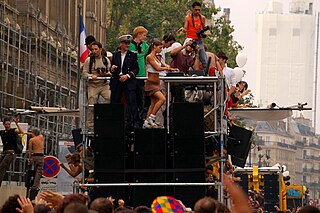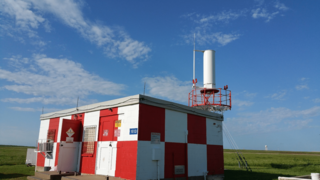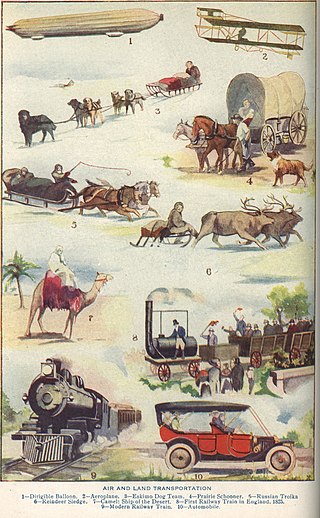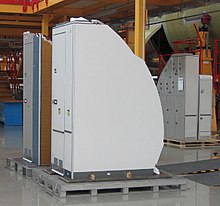
A vehicle is a machine that transports people or cargo. Vehicles include wagons, bicycles, motor vehicles, railed vehicles, watercraft, amphibious vehicles, aircraft and spacecraft.

A winch is a mechanical device that is used to pull in or let out or otherwise adjust the tension of a rope or wire rope.

A warship or combatant ship is a naval ship that is built and primarily intended for naval warfare. Usually they belong to the armed forces of a state. As well as being armed, warships are designed to withstand damage and are typically faster and more maneuverable than merchant ships. Unlike a merchant ship, which carries cargo, a warship typically carries only weapons, ammunition and supplies for its crew. Warships usually belong to a navy, though they have also been operated by individuals, cooperatives and corporations.

The capital ships of a navy are its most important warships; they are generally the larger ships when compared to other warships in their respective fleet. A capital ship is generally a leading or a primary ship in a naval fleet.

Landing craft are small and medium seagoing watercraft, such as boats and barges, used to convey a landing force from the sea to the shore during an amphibious assault. The term excludes landing ships, which are larger. Production of landing craft peaked during World War II, with a significant number of different designs produced in large quantities by the United Kingdom and United States.

A mother ship, mothership or mother-ship is a large vehicle that leads, serves, or carries other smaller vehicles. A mother ship may be a maritime ship, aircraft, or spacecraft.

A camper van, also referred to as a camper, caravanette, motor caravan or RV in North America, is a self-propelled vehicle that provides both transport and sleeping accommodation. The term describes vans that have been fitted out, whereas a motorhome is one with a coachbuilt body.

A technoparade is a parade of vehicles equipped with strong loudspeakers and amplifiers playing Electronic dance music. It resembles a carnival parade in some respects, but the vehicles are usually less elaborately decorated. Unlike some carnival parades, a technoparade does not share the tradition of bombarding the spectators with sweets. However, the revellers do occasionally throw confetti and spray foam from the vehicles onto the crowd.

A platform supply vessel (PSV) is a ship specially designed to supply offshore oil and gas platforms. These ships range from 50 to 100 metres in length and accomplish a variety of tasks. The primary function for most of these vessels is logistic support and transportation of goods, tools, equipment and personnel to and from offshore oil platforms and other offshore structures. In recent years, a new generation of platform supply vessels entered the market, usually equipped with Class 1 or Class 2 dynamic positioning system.
A lighter is a type of flat-bottomed barge used to transfer goods and passengers to and from moored ships. Lighters were traditionally unpowered and were moved and steered using long oars called "sweeps" and the motive power of water currents. They were operated by skilled workers called lightermen and were a characteristic sight in London's docks until about the 1960s, when technological changes made this form of lightering largely redundant. Unpowered lighters continue to be moved by powered tugs, however, and lighters may also now themselves be powered. The term is also used in the Lighter Aboard Ship (LASH) system.

A tactical air navigation system, commonly referred to by the acronym TACAN, is a navigation system used by military aircraft. It provides the user with bearing and distance to a ground or ship-borne station. It is a more accurate version of the VOR/DME system that provides bearing and range information for civil aviation. The DME portion of the TACAN system is available for civil use; at VORTAC facilities where a VOR is combined with a TACAN, civil aircraft can receive VOR/DME readings. Aircraft equipped with TACAN avionics can use this system for en route navigation as well as non-precision approaches to landing fields. The Space Shuttle is one such vehicle that was designed to use TACAN navigation but later upgraded with GPS as a replacement.

A gun turret is a mounting platform from which weapons can be fired that affords protection, visibility and ability to turn and aim. A modern gun turret is generally a rotatable weapon mount that houses the crew or mechanism of a projectile-firing weapon and at the same time lets the weapon be aimed and fired in some degree of azimuth and elevation.

Mode of transport is a term used to distinguish between different ways of transportation or transporting people or goods. The different modes of transport are air, water, and land transport, which includes rails or railways, road and off-road transport. Other modes also exist, including pipelines, cable transport, and space transport. Human-powered transport and animal-powered transport are sometimes regarded as their own mode, but never fall into the other categories. In general, transportation is used for moving of people, animals, and other goods from one place to another. Means of transport, on the other hand, refers to the transport facilities used to carry people or cargo according to the chosen mode. Each mode of transport has a fundamentally different technological solution, and some require a separate environment. Each mode has its own infrastructure, vehicles, transport operators and operations.

Sealift is a term used predominantly in military logistics and refers to the use of cargo ships for the deployment of military assets, such as weaponry, vehicles, military personnel, and supplies. It complements other means of transport, such as strategic airlifts, in order to enhance a state's ability to project power.
Land warfare or ground warfare is the process of military operations eventuating in combat that takes place predominantly on the battlespace land surface of the planet.
A urine collection device or UCD is a device that allows the collection of urine for analysis or for purposes of simple elimination. UCDs of the latter type are sometimes called piddle packs.

A honeywagon is the slang term for a "vacuum truck" for collecting and carrying human excreta. These vehicles may be used to empty the sewage tanks of buildings, aircraft lavatories, passenger train toilets and at campgrounds and marinas as well as portable toilets. The folk etymology behind the name 'honeywagon' is thought to relate to the honey-colored liquid that comes out of it when emptying the holding tanks.

An aircraft lavatory or plane toilet is a small room on an aircraft with a toilet and sink. They are commonplace on passenger flights except some short-haul flights. Aircraft toilets were historically chemical toilets, but many now use a vacuum flush system instead.

An amphibious warfare ship is an amphibious vehicle warship employed to land and support ground forces, such as marines, on enemy territory during an amphibious assault.
Aircraft can have different ways to take off and land. Conventional airplanes accelerate along the ground until sufficient lift is generated for takeoff, and reverse the process to land. Some airplanes can take off at low speed, this being a short takeoff. Some aircraft such as helicopters and Harrier jump jets can take off and land vertically. Rockets also usually take off vertically, but some designs can land horizontally.
















